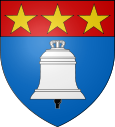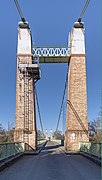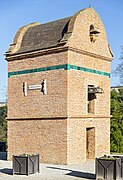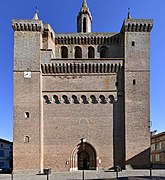Saint-Sulpice-la-Pointe
| Saint-Sulpice-la-Pointe | ||
|---|---|---|

|
|
|
| region | Occitania | |
| Department | Camouflage | |
| Arrondissement | Castres | |
| Canton | Les Portes du Tarn | |
| Community association | Stealth agout | |
| Coordinates | 43 ° 46 ′ N , 1 ° 41 ′ E | |
| height | 95-195 m | |
| surface | 23.99 km 2 | |
| Residents | 9,117 (January 1, 2017) | |
| Population density | 380 inhabitants / km 2 | |
| Post Code | 81370 | |
| INSEE code | 81271 | |
| Website | www.ville-saint-sulpice-81.fr | |
Saint-Sulpice-la-Pointe ( Occitan : Sant Sulpici ; until 2013 only Saint-Sulpice ) is a French commune with 9117 inhabitants (as of January 1, 2017) in the Tarn department in the Occitania region .
Geographical location
Saint-Sulpice-la-Pointe lies on the Tarn at the mouth of the Agout . To the southwest of the municipality, 32 km away, is Toulouse , 46 km northeast of Albi and 48 km northwest of Montauban .
history
Saint-Sulpice was built as a bastide between 1243 and 1247 .
During the Second World War (since October 1939) the " Camp d'internement de Saint-Sulpice" existed here on an area of 3.5 hectares known locally as "Les Pescayres". Until April 1940, the camp was intended for possible war refugees. In fact, 1,500 refugees from German-occupied Belgium were housed here, who soon found accommodation with families in the region. Since October 1940, under the rule of the Vichy regime , the camp was designated by the Interior Ministry under Marcel Peyrouton to house "undesirable elements" (indésirables). After renovations, which served a concentration camp-like character of the camp, 258 people, defined as "communists, syndicalists and other undesirables", have been imprisoned here since January 28, 1941 . Since February 8, 1941, a further 800 people have been imprisoned in this camp, who came from a camp in Oraison (which was subsequently dissolved) . After a number of inmates had been forcibly transferred to the STO since 1942 and were therefore subject to German authorities as forced laborers , the camp was gradually reduced in size.
Notable places and monuments
Web links
- Website of the municipality (French)
Individual evidence
- ^ Pnina Rosenberg: L'art des indésirables. L'art dans des camps d'internement français 1939 - 1940. L'Harmattan, Paris 2003 pp. 170–174.






